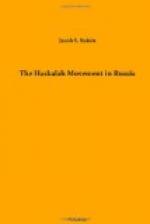But the Jews did not wait for their dreams to be realized. They threw themselves into the swirl of their country’s ambition, as if they had never received anything other than the tenderness of a devoted mother at her hands. They were “kindled in a common blaze” of patriotism with the rest of the population. That in spite of all accusations to the contrary they remained loyal to Poland, is amply proved by the history of that unfortunate country. The characteristic kapota of the Polish Jew, his whole garb, including the yarmulka (under cap), is simply the old Polish costume, which the Jews retained after the Poles had adopted the German form of dress.[3] “When, in the year 1794,” says Czacki, “despair armed the [Polish] capital, the Jews were not afraid of death, but, mingling with the troops and the populace, they proved that danger did not terrify them, and that the cause of the fatherland was dear to them.” With the permission of Kosciusko, Colonel Joselovich Berek, later killed at the battle of Kotzk (1809), formed a regiment of light cavalry consisting entirely of Jews, which distinguished itself especially at the siege of Warsaw. Most of the members perished in defence of the suburb of Praga. In the agony of death, Rabbi Hayyim longed for good tidings, that he might die in peace. And when the fight was over, Zbitkover expended two barrels of money, one filled with gold ducats and one with silver rubles, for the live and dead soldiers who were brought to him.[4] Indeed, Prince Czartorisky was so convinced of their patriotism, that he always advocated the same rights for the Polish Jews as were claimed for the Polish Gentiles, entrusted his children to the care of Mendel Levin of Satanov, and instructed his son, Prince Ladislaus, always to remain their friend.[5]




